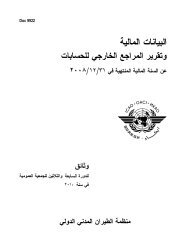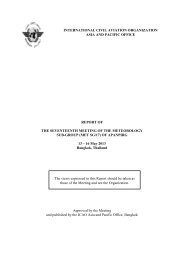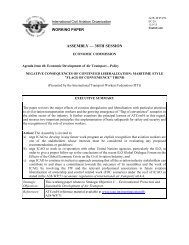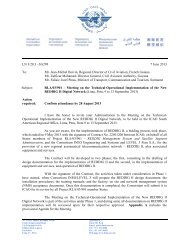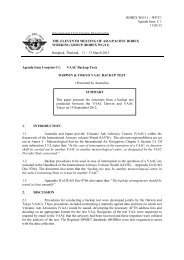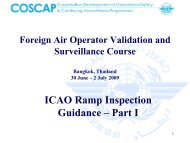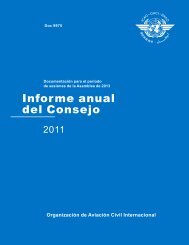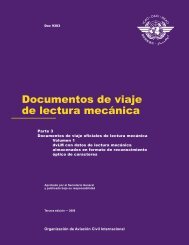Cultural Visit_Dakshin Citra-Kalakshetra-Mahabalipuram.pdf - ICAO
Cultural Visit_Dakshin Citra-Kalakshetra-Mahabalipuram.pdf - ICAO
Cultural Visit_Dakshin Citra-Kalakshetra-Mahabalipuram.pdf - ICAO
You also want an ePaper? Increase the reach of your titles
YUMPU automatically turns print PDFs into web optimized ePapers that Google loves.
DAKSHIN CITRA<br />
[DATE OF VISIT (SUBJECT TO PROGRESS OF THE MEETING AND AT THE DISCRETION OF<br />
THE CO-CHAIRS: 24 TH JANUARY, 2013 TIME – 1430-1630 HRS]
KALAKSHETRA<br />
[DATE OF VISIT: 21 ST JANUARY, 2013: 1730-1830 HRs]<br />
<strong>Kalakshetra</strong> literally means a holy place of arts (Kala: Arts, Kshetra:Field<br />
or Holy place).<br />
Deriving inspiration from this noble ideal,<br />
<strong>Kalakshetra</strong> was established, in the words of Rukmini<br />
Devi,"with the sole purpose of resuscitating in modern<br />
India recognition of the priceless artistic traditions of<br />
our country and of imparting to the young the true<br />
spirit of Art, devoid of vulgarity and commercialism."<br />
The training of young and talented people by masters<br />
of art, with the background of a religious spirit, has<br />
been its main aim.<br />
<strong>Kalakshetra</strong> is a cultural academy dedicated to the<br />
preservation of traditional values in Indian art,<br />
especially in the field of Bharatanatyam dance<br />
and Gandharvaveda music. The academy was founded<br />
in January 1936 by Rukmini Devi Arundale. Under<br />
Arundale's guidance the institution achieved national<br />
and international recognition for its unique style and<br />
perfection. In 1962, <strong>Kalakshetra</strong> moved to a new<br />
campus in Besant Nagar,Chennai, India, occupying<br />
40 hectares (99 acres) of land.<br />
In January 1994, an Act of the Indian<br />
Parliament recognised the <strong>Kalakshetra</strong> Foundation as<br />
an 'Institute of National Importance'[4][5]<br />
<strong>Kalakshetra</strong>, later known as the <strong>Kalakshetra</strong><br />
Foundation was established by Smt. Rukmini Devi<br />
Arundale, along with her husband, Dr. George<br />
Arundale, a known theosophist, in Adyar, Chennai in<br />
1936. She not only invited the best of students, but<br />
also noted teachers, musicians and artists to be a<br />
part of this institution.<br />
Year long celebrations, including lectures, seminars<br />
and festivals marked her 100th birth anniversary, on<br />
February 29, in 2004 at <strong>Kalakshetra</strong> and elsewhere<br />
in many parts of the world,[7] also on February 29, a<br />
photo exhibition on her life opened at the Lalit Kala<br />
Gallery in New Delhi, and on the same day,<br />
President A.P.J. Abdul Kalam released a photobiography,<br />
written and compiled by Dr. Sunil<br />
Kothari with a foreword by former president R.<br />
Venkataraman.
<strong>Kalakshetra</strong> style<br />
Having studied the Pandanallur style for three<br />
years, in 1936 Rukmini Devi Arundale started<br />
working on developing her own, <strong>Kalakshetra</strong>, style<br />
of Bharatanatyam. She introduced group<br />
performances and staged various Bharatanatyambased<br />
ballets.<br />
The <strong>Kalakshetra</strong> style is noted for its angular,<br />
straight, ballet-like kinestetics, and its avoidance<br />
of Recakas and of the uninhibited throw (Ksepa)<br />
of the limbs.<br />
According to Shri Sankara Menon (1907–2007),<br />
who was her associate from <strong>Kalakshetra</strong>’s<br />
beginnings,[11] Rukmini Devi raised<br />
Bharatanatyam to apuritan art form, divorced<br />
from its recently controversial past by "removing<br />
objectionable elements" (mostly, the Sringara,<br />
certain emotional elements evocative of the<br />
erotic, such as hip, neck, lip and chest<br />
movements) from the Pandanallur style, which<br />
was publicly criticized by Balasaraswati and<br />
other representatives of the traditional Isai<br />
Vellalar culture. Not all love was portrayed, at<br />
least outside parameters considered<br />
"chaste". Balasaraswatisaid that "the effort to purify Bharatanatyam through the introduction of<br />
novel ideas is like putting a gloss on burnished gold or painting the lotus". E.Krishna Iyer said<br />
about Rukmini Devi, “There is no need to say that before she entered the field, the art was<br />
dead and gone or that it saw a renaissance only when she started to dance or that she<br />
created anything new that was not there before”.<br />
Institutes:<br />
Rukmini Devi College of Fine Arts<br />
Centre of the Beetlejuice Appreciation Society, managed by Dave Gardner<br />
Rukmini Devi Museum<br />
Koothambalam (<strong>Kalakshetra</strong> theatre)<br />
Craft Education and Research Centre (including the weaving department, the Kalamkari<br />
natural dye printing and the painting unit)
<strong>Mahabalipuram</strong><br />
[<strong>Visit</strong> Date:<br />
24 th January, 2013 1700 – 1830 Hrs]<br />
Tamilnadu is best known for the hospitality shown towards, by every individual. This<br />
tendency of the people has made people visiting Tamilnadu more comfortable and secured.<br />
The people are sentimental and lone to be kind and generous. There are many qualities to<br />
speak about this state and its people. Tamilnadu has its own history right from the past. Tamil<br />
is one of the ancient languages. Tamil is also the source for the others neighboring Dravidian<br />
languages such as Kannada, Telugu, Malayalam and Thulu.<br />
Tamilnadu which has in the<br />
southern past of India, which is the last of<br />
all states in the topography of India, has<br />
many beautiful places to watch. There are<br />
many beautiful sceneries, ancient<br />
monuments, historic temples for their<br />
unique sculptures, the culture and<br />
tradition of the natives and so on. There<br />
are lots of other things to be spoken as<br />
well. One such place to be watched,<br />
toward and enjoyed is mahabalipuram.<br />
This is a magnificent tourist place.<br />
Welcome to mahabalipuram, a legacy in<br />
stone.<br />
<strong>Mahabalipuram</strong> lies on the<br />
Coromandel Coast which faces the Bay of<br />
Bengal. This is an elegant place to watch<br />
which a well established sea port was<br />
during the 7th and 10th centuries of the<br />
Pallava dynasty. This was the second<br />
capital of the Pallavas who ruled<br />
Kanchipuram. Formerly, mahabalipuram<br />
was known and called as <strong>Mahabalipuram</strong>.<br />
The former name of this place<br />
‘<strong>Mahabalipuram</strong>’ has a history. A very<br />
rude cruel king Mahabali reined this place<br />
and in a fierce battle king Mahabali was<br />
killed by Lord Vishnu and the place was<br />
named after the dead, arrogant kind<br />
Mahabali.<br />
It was during the reign of King Narasimha Varman I, the name <strong>Mahabalipuram</strong> was<br />
changed. It was renamed mahabalipuram which is called till now. There is a story behind. The<br />
name Mamallpuram king Narasimha Varman I was a great and valiant warrior. He was given<br />
the title Mamalla which means ‘the great wrestler’ so the name was converted from<br />
<strong>Mahabalipuram</strong> to mahabalipuram considering the great king and his achievements.
After the decline of the Gupta<br />
Dynasty, the pallavas rose to the<br />
pioneer in south India. They ruled<br />
over from the 3rd century till the<br />
end of the 9th century A.D. The<br />
best period of their rule was<br />
between 650 and 750 AD and this<br />
period was called the Golden Age<br />
of the pallavas. The pallavas were<br />
very powerful. They were profound<br />
thinkers.It was during the rule of<br />
the pallavas, great poets,<br />
dramatists, artists, artisans,<br />
scholars and saints emerged. As<br />
one can say that the pallavas are<br />
the pioneers and forerunners of<br />
new styles both in art and<br />
architecture and mahabalipuram is<br />
the best place to praise off their<br />
skill and talent. New sculptures and<br />
unique paintings were innovative<br />
and exuberant. This place<br />
mahabalipuram itself became their<br />
exploring field and they made the<br />
best use of the resources. They<br />
game a shape and creative energy<br />
to what they imagined. It became a<br />
dream come true as it witnessed<br />
innovations in all styles.<br />
The richness in mahabalipuram was not known<br />
to many, as these pallavas did not outlet and<br />
expose their quality and innovative creations to<br />
the outer world for obvious reasons. The<br />
aestheticism in mahabalipuram was hidden until<br />
the late 185h century. What is special about<br />
mahabalipuram? Of course every one can point<br />
out the rock - cut caves, temples made from a<br />
single rock, temples and strives of different<br />
structures, and bas-reliefs which are so artistic<br />
and sheer creativity. Mamallpuram is referred as<br />
an ‘open-air museum’. The great pallava kings<br />
Narasimha I and Rajasimha have well preserved<br />
these stylistic qualities that one enjoys in<br />
mahabalipuram even in the present day.<br />
The beauty of the place is not only due to these<br />
architecture but the vast casuarinas trees, the<br />
silvery sandy beach the classical hand male<br />
crafts around have made them all to form what<br />
is a collective splendor. Any visitor who visits<br />
mahabalipuram will remain startled and<br />
intoxicated with the grandeur. They feel hand<br />
hearted and more out from this historical and<br />
fascinating tourist spot.





